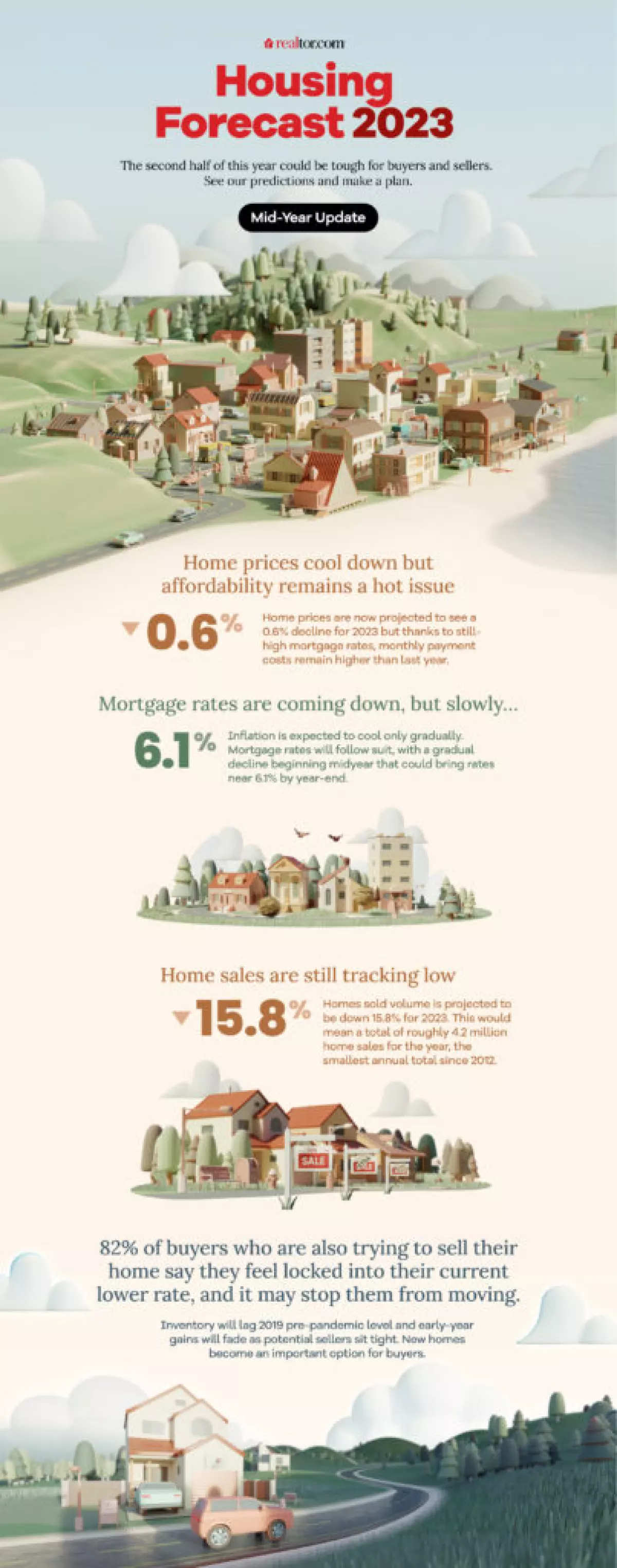
The National Housing & Economic Forecast for 2023 presents a mid-year update that reveals a mixed picture for the housing market. While home prices have started to ease, the persistently high costs continue to impact affordability. Let's dive deeper into the key insights from the forecast and understand the ongoing trends.
A Closer Look at the Housing Forecast
Mortgage Rates and Affordability
Mortgage rates have been revised lower to reflect the drop in late 2022. However, affordability remains a significant challenge, particularly in the West. As a result, the forecast predicts a decline in home prices by 0.6% for 2023 as a whole.
Home Sales and Inventory
Home sales are expected to decline by 15.8% in 2023, totaling around 4.2 million sales for the year. This decrease is primarily attributed to mortgage rate lock-ins, which have had a stronger impact than initially anticipated. Additionally, the number of homes for sale has not met initial projections, resulting in a modest slip of 5% in inventory for the year.
Revised Forecast for Key Housing Indicators
Here's a comparison of the revised Realtor.com forecast for key housing indicators in 2023:
| Housing Indicator | Realtor.com 2023 Forecast REVISED | Realtor.com 2023 Forecast (Nov. 2022) | 2022 Historical Data |
|---|---|---|---|
| Mortgage Rates | Average 6.1% by year-end | Average 7.1% by year-end | Average 6.7% |
| Existing Home Median Sales Price | -0.6% | +5.4% | +10.2% |
| Existing Home Sales | Down 15.8% | -14.1% | -17.8% |
| Existing Home For-Sale Inventory | Down 5% | +22.8% | - |
| Single-Family Home Housing Starts | -19.6% | -5.4% | -10.6% |
| Homeownership Rate | 65.7% | 65.7% | 65.8% |
| Rent Change | -0.9% | +6.3% | +10.9% |
The Economic Landscape
Gradual Receding of Inflation
Although the inflation rate has shown signs of moderating, it remains above the Federal Reserve's target. Despite recent improvements, both the PCE price index and the Consumer Price Index remain more than double the 2% target. The Federal Reserve is cautiously optimistic but acknowledges that the end goal of moderate inflation has not yet been achieved.
Monetary Policy and Rate Expectations
Inflation's persistence has led to an upward adjustment in expectations for the appropriate policy rate. While the Federal Reserve has signaled the eventual end of tightening, it has raised the Fed Funds rate to a range of 5.0 to 5.25%. The Fed does not anticipate rate cuts in 2023, and investors are preparing for higher rates in the long term.
Steady Economic Growth and Labor Market Performance
Economic growth and hiring are expected to slow down, with a revised annual growth rate of 1.6%. However, the labor market has been outperforming expectations, with low unemployment rates and higher-than-expected job additions. Despite wage growth exceeding pre-pandemic levels, the rising costs of goods and services have eroded purchasing power for households.
Declining Home Sales
Home sales are projected to decline further on an annual basis, with an expected total of 4.2 million sales in 2023. Affordability challenges and limited buying power contribute to this trend.
Mortgage Lock-In and Inventory Challenges
A lack of available homes for sale and mortgage rate lock-ins have hampered the housing market. Sellers are hesitant, with many feeling locked in by their existing low-rate mortgages. As a result, the forecast predicts a small decline of 5% in inventory for the year.
Home Prices and Affordability
While home prices have shown a decline, they remain elevated, especially in the West. Affordability concerns persist due to high mortgage rates. Monthly payments in 2023 are expected to be 10.5% higher than the previous year.
Creative Solutions and Rental Market Demand
Higher costs have pushed households to be creative in navigating the housing market. Down payments have declined, offering opportunities for buyers with limited funds. However, due to high housing prices and mortgage rates, many renters are delaying their home purchases and choosing to stay in the rental market. This has led to strong demand for rental properties, with the rental market expected to remain competitive.
Surge in Multi-family Construction
The supply side of the rental market is experiencing a surge in multi-family construction. With an increasing number of completed units and a growing rental vacancy rate, the competition in the rental market is expected to ease. However, property owners may face challenges in filling vacancies.
In conclusion, the National Housing & Economic Forecast for 2023 reveals a mixed outlook for the housing market. While home prices have started to ease, costs remain high, impacting affordability. The decline in home sales, coupled with inventory challenges, adds further complexity to the market. However, the surge in multi-family construction provides renters with more options. As the year progresses, it will be essential to monitor these trends and their impact on the housing market.











